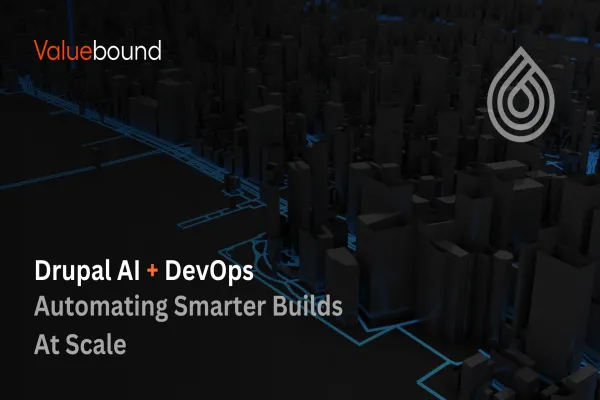There’s a hard truth every digital team eventually confronts: building with Drupal isn’t slow—working around it is. In many cases, the very flexibility that makes Drupal so powerful becomes the reason projects stall.
At DrupalCon Atlanta 2025, Dries Buytaert captured this challenge precisely: “We have to evolve not just the software—but the way we collaborate, launch, and maintain.” That’s not an abstract idea. It’s a roadmap.
So what’s really holding back your Drupal projects? It’s rarely one thing. But understanding the common friction points—across planning, architecture, and tooling—can unlock enormous velocity.
And now, with AI in Drupal finally becoming operationally real, many of these bottlenecks have solutions baked in.
Misaligned Planning and Over-Spec’ing
The first slowdown rarely starts in code—it begins in a meeting. Projects built on outdated assumptions or misaligned stakeholder expectations are expensive to fix. Drupal’s ecosystem is vast, with thousands of contributed modules. But without clear feature scoping tied to business outcomes, teams tend to overbuild.
The fix is structural. Modern Drupal CMS, especially post-Starshot, is shifting toward opinionated defaults. Recipes—Drupal’s new pre-configured site blueprints—were built specifically to solve this. By defining working examples with real architecture and modules included, they provide clarity in the earliest stages of planning.
Dries emphasized that “recipes are about removing friction, not flexibility.” They create guardrails. And when AI in Drupal supports those recipes with context-aware suggestions, planning transforms from guesswork into a guided path.
Legacy Code and Technical Debt
Older Drupal projects often carry technical debt from previous releases, particularly from migrations out of Drupal 7 or 8. It’s not just code quality—it’s outdated architecture, procedural patterns, or rigid module stacks.
That legacy debt blocks progress. Teams hesitate to update because they’re uncertain what will break. Testing is fragmented. Rollbacks feel risky. This is where Drupal AI steps in with emerging support for code auditing and automated test generation.
In Atlanta, the core team previewed an AI-powered tool that scans modules for outdated hooks and insecure patterns. It doesn’t just flag them—it recommends the updated implementation. This isn’t speculative. These features are rolling out now.
With Drupal AI analyzing code, surfacing risks, and automating refactors, old projects can move forward without a full rebuild. That changes everything.
Disconnected Front-End Workflows
Even with the best backend setup, delays often surface at the front end. Theme development in Drupal is still more complex than it needs to be—especially when designers and developers work in parallel without shared standards.
Many teams spend weeks just syncing design tokens, layout structures, and custom templates. But the Experience Builder, as demoed live at DrupalCon Atlanta, directly addresses this bottleneck.
It lets teams visually create layouts using reusable sections and global regions. More importantly, it stores those definitions in structured formats that developers can hook into. That eliminates the long handoff phase that normally kills momentum.
With AI in Drupal gradually assisting in layout prediction and automated theming (still in beta), the time between design and delivery is shrinking. That’s not just speed—it’s reliability.
Weak Local Environments and Slow Onboarding
One of the most invisible delays in Drupal work is the first-day setup. New team members often lose hours (or days) configuring local environments, solving dependency issues, or aligning databases.
That’s why the new Drupal CMS includes a desktop installer, built by Gábor Hojtsy’s team, that ships everything in a self-contained app. No command line, no Docker, no guesswork. Just download, install, and start.
This is already saving time across agencies and enterprise teams. And for teams using Drupal AI, the next phase will include guided onboarding based on role. Designers, developers, marketers—each get what they need first.
This intentional rethinking of the local experience is long overdue. Now that it’s here, the velocity gains are significant.
Unoptimized Content Workflows
Content operations are the heartbeat of most Drupal projects. And often, they’re what slows everything down. Review loops are chaotic. Editors and developers step on each other’s changes. Drafts disappear. Deadlines drift.
The new multisite editing and drafts system inside Experience Builder is addressing this directly. Editors can now make changes across multiple pages in one session, save drafts per user, and only publish when ready.
But what’s more impressive is how Drupal AI is becoming part of the authoring flow. AI-powered suggestions for metadata, accessibility fixes, alt text generation, and even layout nudges are starting to surface in experimental builds.
This isn’t just automation—it’s augmentation. When editors are empowered with real-time, smart support, they move faster and make fewer mistakes. That’s velocity at scale.
Dependency Overload
Many Drupal teams build stacks that are too large, too brittle, and too hard to maintain. Dozens of modules, each with its own dependencies and upgrade cycles. In fast-paced environments, this becomes unsustainable.
The Starshot initiative’s shift to a smaller, more curated set of defaults—combined with recipes—is reducing this footprint. But even better, Drupal AI is now beginning to recommend module choices based on site usage patterns.
Instead of picking a layout builder from a forum post, teams can see what’s working across similar Drupal sites. And when security issues surface, they’re flagged immediately, reducing risk without waiting on manual updates.
This is where Drupal gets smarter. And that intelligence is being built by the same community that maintains the ecosystem itself.
The Human Factor
No tool or AI model can solve misalignment, indecision, or burnout. The final reason Drupal projects slow down is human: communication gaps, lack of ownership, or unclear process.
But this is exactly where the Drupal community thrives. The entire Starshot release was a testament to coordinated volunteer contribution, strong leadership, and shared momentum.
Dries put it plainly in Atlanta: “Decline is a choice. We chose to evolve.” That culture of action is now embedded in the roadmap. The Drupal Association is supporting makers not just with software, but with marketing, onboarding, and partner outreach.
Teams that lean into that momentum move faster—because they’re not working alone.
Final Thought: Momentum Is a System
Fixing what slows down your Drupal project isn’t about finding a silver bullet. It’s about adopting a system—where architecture, automation, and collaboration are aligned.
The modern Drupal CMS isn’t slower than the market. It’s faster than it’s ever been. With AI in Drupal and Drupal AI unlocking performance, clarity, and smarter defaults, teams now have fewer excuses and more opportunities.
Velocity is a choice. And this time, it’s built in.





